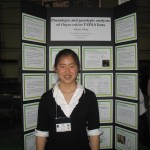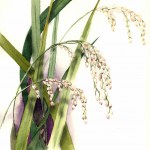Ronald research
Tomorrows Table: What does GMO really mean?
For years, journalists, television producers and newspaper reporters that write about genetically engineered crops, have used the term “GMO” (genetically modified organism) to describe these new crop varieties. The marketing industry has taken to writing “GMO-free” on their products, as a way to increase sales to consumers fearful of the genetic engineering process.The problem is that the term GMO is misused and misunderstood.Take, for example, a recent story on Voice of America about a newly developed rice variety that is tolerant of flooding.…
I was so pleased to have a chance to take part in the Women in Science Symposium at Cornell April 2-3.
Thanks to the Cornell faculty and students that put together this wonderful event. For those that could not attend, read the graduate student interviews with the speakers here.
Dr. Mary Power is director of the Angelo Coast Reserve, leader in scientific societies, mentor to many successful students, and as an influential figure in several environmental policy debates.
Dr. Sharon Long is member of National Academy of Sciences and served as science advisor to President Obama during his…
Jonathan Eisen, scientist and blogger extraordinaire has established a science writing series called "Story behind the paper". The idea is for authors who have recently published Open Access papers to tell the story behind the paper: what sorts of experiences and experiments led up to the new discovery and how we navigated through the publication process. Several years ago Jonathan patiently explained to me what a blog was and got me started with science blogging. He recently kindly extended an invitation to write story about our discovery of a new communication code in disease causing…
Finally our paper is in press!
in the coming issue of PNAS, we describe a genome-scale model for predicting the functions of genes and gene networks in rice, an important staple food. Called RiceNet, this systems-level model of rice gene interactions allows us to effectively predict gene function. This information can be used to help boost the production and improve the quality of one of the world's most important food staples.
This graphic is a full-size view of a RiceNet layout, color-coded to indicate the likelihood of network links; red for higher and blue for lower likelihood scores…
No investigation without wonder, no observation without joy, no understanding without humility.
Today Malinee Sriariyanum was awarded the John E. Kinsella Prize for her work on isolation and characterization of the Ax21 pathogen associated molecular pattern.
The joyful awardee and her proud mentors:
Associate Dean Jan Hopmans, Malinee Sriariyanun, and myself
Merry Mou won first place in the Synopsys Silicon Valley Science and Technology Championship. 700 to 900 students participate with their research projects in a variety of categories, including physics, biology, and computer science. Winners are chosen to go on to state and national competitions.
Merry Mou won 1st place in Botany in the 2010 Championship for her project, Phenotypic and Genotypic Analyses of Oryza Sativa T-DNA Lines, which was completed in the summer of 2010 as part of the Young Scholars Program under the guidance of postdoctoral fellow Manoj Sharma. She will be participating…
The last common ancestor of plants and animals may have lived 1 billion years ago. Plants and animals have occasionally exchanged genes, but for the most part, have countered selective pressures independently. Microbes (bacteria, eukaryotes, and viruses) were omnipresent threats, influencing the direction of multi-cellular evolution. Receptors that detect molecular signatures of infectious organisms mediate awareness of non-self, and are integral to host defense in plants and animals alike. The discoveries leading to identification of these receptors and their ligands followed a similar…
Ed Yong recently published a post called "On the origin of science writers" asking that science writers (anyone who regularly writes about science) tell the story of how they got started. The idea is to establish a resource for future writers. I joined the thread and have reprinted it here.
As far back as I can remember I loved to read and I loved the wilderness. In fact my favorite times were reading in the wilderness, preferably in a tree near our mountain cabin, high enough where my brothers could not reach me with stones or snowballs.
I did not think much about being a writer myself until…
> WASHINGTON- (AP) The leader of the United States Department of
> Agriculture's National Institute for Food Research, Dr. Roger Beachy,
> admitted that the release of last week's request for proposals (RFP)
> from scientific researchers was "simply a gag to lighten the research
> funding environment" and that the real one will be released this week.
>
> "Researchers are too stressed out; it seems that all they do is write
> grants. The request for proposals to address extremely finite subject
> areas would alienate 95% of them and give them all an opportunity…
The word is spreading- we can feed the world without damaging it, if we can entertain some new ideas.
Check out Paul Voosen's article in the NYT and let me know what you think.
The Daily Star of Dhaka reports today that flood-tolerant rice will soon be officially released in Bangladesh.
The flood-tolerant rice varieties (called Sub1- rice) can help farmers, many who live on less than $1/day, dramatically increase yield during floods.
Dave Mackill of the International Rice Research Institute (formerly of UC Davis) led the precision breeding efforts. The team introduced the Sub1 gene into BR-11 and three other varieties that are popular with farmers and consumers. The new BR-11 Sub1 variety has been embraced by farmers in field trials because it is effectively…
In plant and animal innate immunity, like many of the dances of life, it takes two to tango. A receptor molecule in the plant pairs up with a specific molecule on the invading bacteria and, presto, the immune system swings into action to defend against the invasion of the disease-causing microbe.
Unwrapping some of the mystery from how plants and bacteria communicate in this dance of immunity, hardworking scientists in my laboratory here at the University of California, Davis, have identified the bacterial molecule that matches up with a specific receptor in rice plants to ward off a…

